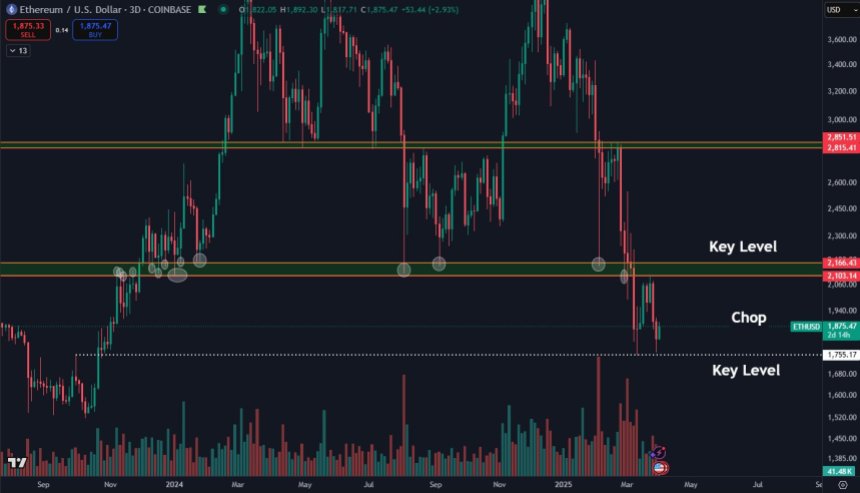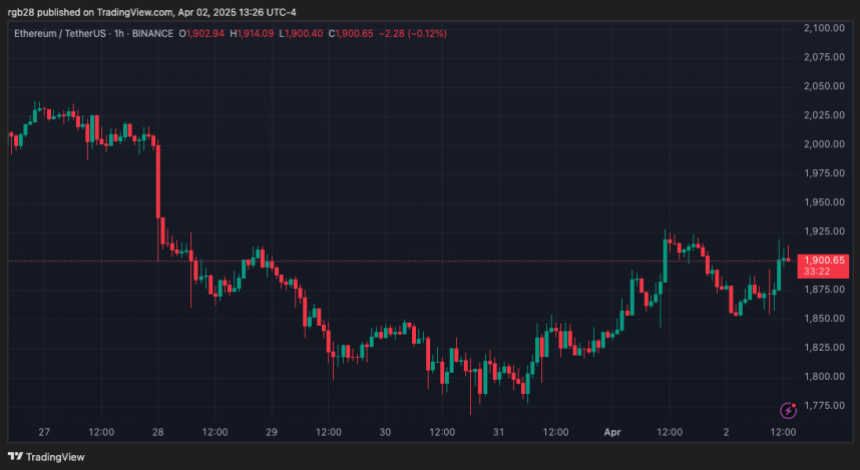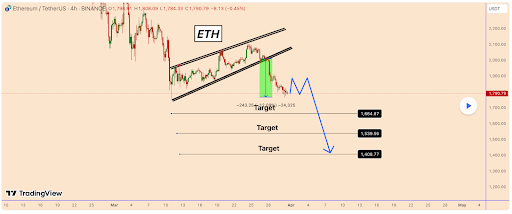Ethereum
Ethereum Targets 100,000 TPS With Buterin’s ‘The Surge’ Plan

In a new blog post titled “Possible futures for the Ethereum protocol, part 2: The Surge,” Ethereum co-founder Vitalik Buterin outlined an ambitious roadmap aiming to scale Ethereum’s transaction processing capacity to over 100,000 transactions per second (TPS) across Layer 1 (L1) and Layer 2 (L2) solutions. This initiative, known as “The Surge,” seeks to enhance scalability while preserving decentralization and security.
Buterin began by reflecting on Ethereum’s initial scaling strategies, which involved sharding and Layer 2 protocols like state channels and Plasma. At the beginning, Ethereum had two scaling strategies in its roadmap, he wrote, pointing to a 2015 paper that discussed sharding—a method where each node only needs to verify and store a fraction of the transactions. This approach mirrors how peer-to-peer networks like BitTorrent operate.
Simultaneously, Layer 2 protocols were developed to offload computation and data from the main chain while leveraging Ethereum’s security. Rollups emerged in 2019 as a powerful Layer 2 solution, requiring significant on-chain data bandwidth. “Fortunately, by 2019 sharding research had solved the problem of verifying ‘data availability’ at scale. As a result, the two paths converged, and we got the rollup-centric roadmap which continues to be Ethereum’s scaling strategy today,” Buterin explained.
Ethereum Roadmap: The Surge
The Surge aims to achieve several key goals: reaching 100,000+ TPS on L1 and L2, preserving the decentralization and robustness of L1, ensuring that at least some L2s fully inherit Ethereum’s core properties of trustlessness, openness, and censorship resistance, and maximizing interoperability between L2s to make Ethereum feel like a unified ecosystem.

One of the primary techniques to achieve these goals is Data Availability Sampling (DAS). Currently, Ethereum’s L1 data bandwidth is limited, capping rollup TPS at approximately 174. To break this barrier, Ethereum plans to implement PeerDAS, a form of one-dimensional sampling that allows nodes to verify data availability efficiently.
“Our medium-term target is 16 MB per slot, which if combined with improvements in rollup data compression would give us ~58,000 TPS,” Buterin noted. Further into the future, two-dimensional sampling could be adopted to enhance efficiency, albeit with increased complexity. “We need much more work figuring out the ideal version of 2D DAS and proving its safety properties,” he added.
Data compression techniques are also crucial in reducing the data footprint of transactions. These include signature aggregation using BLS signatures, replacing addresses with pointers to historical data, and custom serialization for transaction values. “We can thus represent most currency values very compactly with a custom decimal floating point format, or even a dictionary of especially common values,” Buterin suggested.
Generalized Plasma is another significant component of The Surge. Plasma allows for off-chain transactions with on-chain security assurances. By incorporating SNARKs (Succinct Non-interactive Arguments of Knowledge), Plasma becomes more powerful and generalizable. “Even if you can only protect a subset of assets […] you’ve already greatly improved on the status quo of ultra-scalable EVM, which is a validium,” he stated.
Buterin also emphasized the need to mature L2 proof systems. Most rollups today are not fully trustless, relying on security councils that can override proof systems. He stressed the importance of reaching “Stage 2” rollups, which are fully trustless and secure. This involves formal verification, using mathematical techniques to prove that proof systems align with the EVM specification.
“We can make a formally verified SNARK prover of a minimal VM,” he explained. Additionally, deploying multiple proof systems, or “multi-provers,” ensures redundancy and security. “If the proof systems agree, the security council has no power,” Buterin highlighted.
Enhancing cross-L2 interoperability is also a key focus. One major challenge is making the L2 ecosystem seamless for users. Buterin proposed several improvements, such as chain-specific addresses that include the chain identifier to simplify cross-L2 transactions, standardized payment requests for easy and secure requests for payments across different chains, and developing protocols like ERC-7683 and RIP-7755 for efficient asset exchanges and gas payments.
Buterin also advocated for light clients and keystore wallets to allow users to verify chains without relying on RPC providers and to simplify key management across chains. “Our ability to handle this problem successfully is a test of our ability to stick together as a community,” Buterin asserted.
While L2 scaling is vital, enhancing L1 remains crucial for Ethereum’s security and economic viability. Buterin discussed strategies like increasing the gas limit, making specific operations cheaper through proposals like EOF (EVM Object Format), and exploring native rollups. “A big question that any L1 scaling roadmap needs to answer is: what is the ultimate vision for what belongs on L1 and what belongs on L2?” he posed, emphasizing the need for balance to maintain Ethereum’s core strengths.
Buterin concluded, “Now our task is to bring the rollup-centric roadmap to completion, and solve these problems, while preserving the robustness and decentralization that makes the Ethereum L1 special.”
At press time, ETH traded at $2,625.

Featured image created with DALL.E, chart from TradingView.com
Ethereum
Ethereum Faces ‘Hyperinflation Hellscape’—Analyst Reveals Key On-Chain Insights

Ethereum (ETH) continues to underperform in the broader cryptocurrency market, currently trading just below $1,800 after falling 4% in the past 24 hours. Despite a strong start to the year, where the crypto market experienced bullish momentum, ETH has failed to sustain its upward trajectory.
Since slipping below the $3,000 level, the asset has largely ranged downward and has now breached the $2,000 support zone, signaling weakening demand and sentiment.
While Bitcoin and other major digital assets still managed to see some recovery efforts in recent weeks, Ethereum’s price decline has been accompanied by decreasing network activity and weakening on-chain fundamentals.
This divergence has raised concerns over ETH’s short-term outlook and prompted a fresh analysis of the underlying causes driving the asset’s performance.
Fee Decline and Network Inactivity Fuel Inflationary Pressures
CryptoQuant analyst EgyHash recently published a report highlighting key on-chain metrics that suggest Ethereum’s current market weakness is closely tied to its declining fee economy and user activity.
According to the report titled: “Why Ethereum Is Bleeding Value: Fee Crash Meets Hyperinflation Hellscape.” Ethereum’s network is experiencing its lowest levels of activity since 2020.

Daily active addresses have declined steadily since early 2025, and average transaction fees have dropped to record lows. This reduction in activity has led to a sharp fall in Ethereum’s burn rate, a metric crucial in offsetting inflationary pressures following the network’s transition to proof-of-stake.
The Dencun upgrade, which was expected to enhance network efficiency, has coincided with an extended period of low transaction volumes, further reducing fee income and contributing to higher net ETH issuance.

EgyHash concludes that the confluence of weak network engagement, reduced burn rate, and high token inflation is central to Ethereum’s declining valuation.
Why Ethereum Is Bleeding Value
“Ethereum’s recent underperformance can be largely attributed to diminished network activity, as evidenced by declining active addresses and reduced transaction fees.” – By @EgyHashX pic.twitter.com/fgQJYCrOIn
— CryptoQuant.com (@cryptoquant_com) April 3, 2025
Ethereum Technical Outlook Signals Potential Support
Despite on-chain headwinds, some technical analysts maintain a cautiously optimistic view. Trader Courage, a technical analyst on X, noted that Ethereum is currently testing a major support zone and could rebound toward the upper resistance of its current trading range.
Back at the green support line. Looks like we could be heading towards the top of the range.
Key levels are on the chart.#Ethereum pic.twitter.com/rRX8b3b6nW
— Trader Courage
(@CryptoCourage1) April 3, 2025
Another market analyst, CryptoElite, shared a long-term ascending trendline that ETH has respected historically. Based on this trend, the analyst believes ETH could still have the potential to rally to $10,000 later in the year, provided broader market conditions improve.
Featured image created with DALL-E, Chart from TradingView
Ethereum
Ethereum Trading In ‘No Man’s Land’, Breakout A ‘Matter Of Time’?

Reason to trust

Strict editorial policy that focuses on accuracy, relevance, and impartiality
Created by industry experts and meticulously reviewed
The highest standards in reporting and publishing
Strict editorial policy that focuses on accuracy, relevance, and impartiality
Morbi pretium leo et nisl aliquam mollis. Quisque arcu lorem, ultricies quis pellentesque nec, ullamcorper eu odio.
Ethereum (ETH) continues failing to reclaim the $2,100 resistance, dropping 6% in the past week. As the second largest crypto trades within its “make or break” levels, some market watchers suggest it will continue to move sideways before another major move.
Related Reading
Ethereum Trades At 2023 Levels
After closing its worst Q1 since 2018, Ethereum continued moving sideways, hovering between the $1,775-$1,925 price range. Amid last Monday’s recovery, Ethereum traded only 6% below its monthly opening, eyeing a potential positive close in the monthly timeframe.
Nonetheless, the cryptocurrency fell over 10% from last week’s high to close the first quarter 45.4% below its January opening and 18.6% from its March opening. Moreover, it registers its worst performance in seven years, recording four consecutive months of bleeding for the first time since 2018.
Daan Crypto Trades noted that ETH is “still trading in no man’s land” despite its recent attempts to break above its current range. In early March, Ethereum dropped below the $2,100 mark, losing its 2024 gains and hitting a 16-month low of $1,750.

The trader suggested that the crucial levels to watch are a breakdown below $1,750 or a breakout above $2,100. “Anything in between is just going to be a painful chop,” he added.
Another market watcher, Merlijn The Trader, highlighted that ETH is at 2021 levels, pointing that it is trading within the breakout zone that led to Ethereum’s all-time high (ATH) but has stronger fundamentals and more institutional demand four years later.
“ETH is sitting on the same monthly support that ignited the 2021 bull run. Hold it, and $10K is in play. Lose it… and things get ugly,” he detailed.
More Chop Before ETH’s Next Move?
Analyst VirtualBacon considers that Ethereum will continue to trade within its current price range for the time being. He explained that ETH’s price has fallen to retest the last bear market resistance levels, as it has erased all its gains since November 2023.
The analyst considers this zone a “good value range” but doesn’t expect the cryptocurrency to break out “right away.” However, he added that a bullish breakout is “simply a matter of time” in longer timeframes.
“Ethereum always catches up when the Fed pivots and the global liquidity index beings to uptrend. That’s when you see the ETH/BTC ratio start to turn up again, leading the rest of the altcoin market,” he concluded.
Related Reading
Ali Martinez pointed out that the number of large ETH transactions has significantly declined in over a month, dropping 63.8% since February 25.
During this period, large transactions fell from 14,500 to 5,190, signaling a drop in whale activity on the network. He also noted that whales have sold 760,000 ETH in the last two weeks.
As of this writing, Ethereum trades at $1,903, a 6% drop in the weekly timeframe.

Featured Image from Unsplash.com, Chart from TradingView.com
Ethereum
Why A Massive Drop To $1,400 Could Rock The Underperformer

Reason to trust

Strict editorial policy that focuses on accuracy, relevance, and impartiality
Created by industry experts and meticulously reviewed
The highest standards in reporting and publishing
Strict editorial policy that focuses on accuracy, relevance, and impartiality
Morbi pretium leo et nisl aliquam mollis. Quisque arcu lorem, ultricies quis pellentesque nec, ullamcorper eu odio.
Crypto analyst Klejdi has indicated that Ethereum’s pain is far from over, with the second-largest crypto by market cap set to suffer a further downtrend. Specifically, he warned that ETH could still drop to as low as $1,400 before it finds a bottom.
Ethereum May Still Drop To As Low As $1,400
In a TradingView post, Kledji stated that Ethereum may drop to $1,400, providing a bearish outlook for the altcoin, which has underperformed other top cryptocurrencies. The analyst noted that ETH lost nearly 12% of its value within just three days after breaking out of its recent pattern last Friday.
Related Reading
He further mentioned that Ethereum’s movement and the rest of the crypto market are closely tied to Bitcoin. As such, this ETH crash is likely to happen, seeing as the flagship crypto has dropped to $81,300 and is already showing signs of further decline.
Klejdi highlighted in his accompanying chart that ETH will likely consolidate near its current level before continuing to move lower. However, the chart showed that the move to this $1,400 target will likely happen this month.

In the meantime, the analyst believes it would be wise to wait for Ethereum’s price to form another bearish pattern before entering a trade. He again reaffirmed that there is a strong possibility that ETH may extend its drop to $1,400.
Ethereum whales are already capitulating ahead of this projected price crash. Onchain analytics platform Lookonchain revealed an ETH OG that has sold off all its holdings. This investor bought 5,0001 ETH while trading at $277 in 2017 and didn’t sell when the altcoin hit its ATH during the last bull run. The whale started selling last month, possibly giving up on Ethereum making a comeback anytime soon.
ETH Will Still Reach New Highs
Crypto analyst Virtual Bacon is still confident that Ethereum will reach new highs. He noted that ETH is back at its key bear market breakout zone, retesting the $1,700 and $2,100 range. He predicts that the altcoin will continue to chop around this range in the short term. However, he remarked that Ethereum tends to catch up fast once the US Federal Reserve pivots and global liquidity turns.
Related Reading
Crypto analyst Crypto Patel affirmed that Ethereum’s biggest run is coming. He stated that Q2 to Q4 of this year will be life-changing for ETH. The analyst added that this could be the cycle top window and advised market participants not to miss it. Crypto Patel advised that they should accumulate between $1,900 and $1,300 with the target of between $7,000 and $10,000 in mind.
At the time of writing, the Ethereum price is trading at around $1,850, up in the last 24 hours, according to data from CoinMarketCap.
Featured image from iStock, chart from Tradingview.com
-

 Regulation23 hours ago
Regulation23 hours agoUS Senate Banking Committee Approves Paul Atkins Nomination For SEC Chair Role
-

 Market21 hours ago
Market21 hours agoBinance Managed 94% of All Crypto Airdrops and Staking Rewards
-

 Market23 hours ago
Market23 hours agoTRUMP Token Hits Record Low Due To Liberation Day Tariffs
-

 Market22 hours ago
Market22 hours agoPi Network Price Falls To Record New Low Amid Weak Inflows
-

 Regulation20 hours ago
Regulation20 hours agoUS SEC Acknowledges Fidelity’s Filing for Solana ETF
-

 Market18 hours ago
Market18 hours agoWormhole (W) Jumps 10%—But Is a Pullback Coming?
-

 Altcoin18 hours ago
Altcoin18 hours agoAltcoin Season Still In Sight Even As Ethereum Struggles To Gain Upward Momentum
-

 Market20 hours ago
Market20 hours agoXRP Battle Between Bulls And Bears Hinges On $1.97 – What To Expect























